All entries for Tuesday 27 October 2009
October 27, 2009
A research methodology using Mindmanager concept mapping & design thinking
In this entry I describe how I am using technology to support my iterative design-thinking based research process.
My approach is based upon the "design thinking" methodology. The process works as iterations of "inspiration, ideation, implementation" in which an initial emphasis upon "inspiration" shifts (but not completely) through time towards an emphasis upon "implementation":
- Being inspired by the work of other researchers and practitioners, along with first-hand encounters in the world (in teaching, learning, design etc);
- Abstracting from this concepts, propositions, variables, etc;
- Creating conjectures about the world (or in design-language "prototypes") based upon those ideas;
- Creating opportunities to realistically test those conjectures;
- Reporting upon the success or failure of the conjectures, and their implications;
- Forming further iterations and directions for research.
I record my research activities upon a concept map (using the sophisticated Mindmanager mapping tool), in a Warwick Blogs blog (linked to from within the map, and keyword tagged using the same schema as the map), and as annotations on pdf files (using a Mac, searchable with Spotlight). The map is structured at the top level as follows:
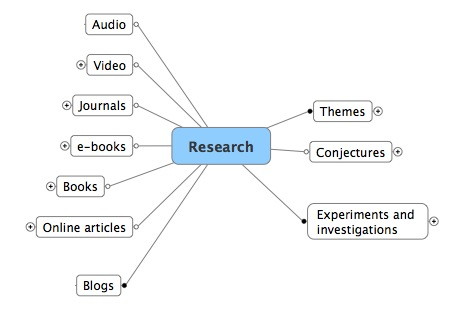
The left-hand side of the map records my readings, along with videos and audio podcasts. Further "inspiring" events and materials are recorded on my Inspires Learning blog, and tagged as "inspiration" (to be added to the map shortly). I like to group my readings together according to source, as this gives me a sense of where I am finding good materials. For example, the Journals node already indicates sources that I am finding to be rich in useful materials:

Opening up the Books node reveals how I am working through the contents of some key books chapter by chapter. I will often write a review of each chapter in my blog. Records in the blog are linked to such literature review blog entries. See how I have added a "task completion" counter to the "Developing Creativity in Higher Education" book, indicating my progress through the book. I will be making further use of icon tagging and task tagging to manage the process. Some of the nodes (especially in Journals and e-Books) contain actual electronic articles as attachments.
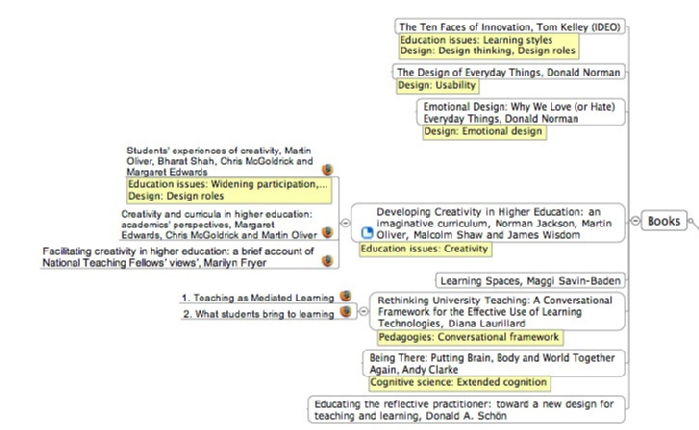
You can also see how each item of literature is being classified using a range of text tags. For example, one article is tagged as being relevant to the "widening paricipation" issue. This keyword tag schema is being developed in the Themes section on the right hand side of the map. I have organised my concepts, issues etc in the following top-level categories:

Opening up the Education Issues node reveals the issues that I am investigating. These issues guide my research process - anything that can have a positive impact here is more worthwhile. I can also assess the impact of conjectures and their consequent practices against their impact on these issues:
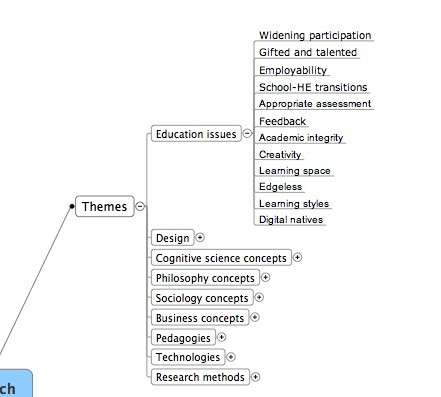
The Design node reveals the concepts taken from the design industry that I am porting across to education. I can use this to unveil the novelty of these approaches, as well as seeking connections in existing pedagogical practice and theory.
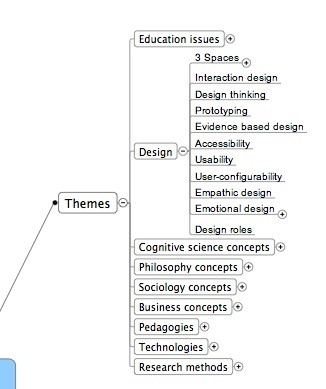
The Pedaogogies node lists existing paradigms with which I can seek such connections and contrasts:
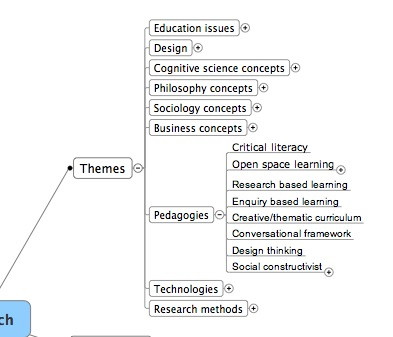
All of these concepts and issues appear within the literature that I am pursuing. Literature records on the left hand side are tagged using terms from the right hand side. As I proceed, I will be able to see areas that need more investigation (using icon markers to identify priorities).
Finally, I will be constructing new ideas and arguments in the Conjectures node. I expect this to become more expansive, detailled and tightly argued as I step through iterations of the discovery-prototype-test process. The Experiments and Investigations node will contain details of formal approaches to evaluating my conjectures:
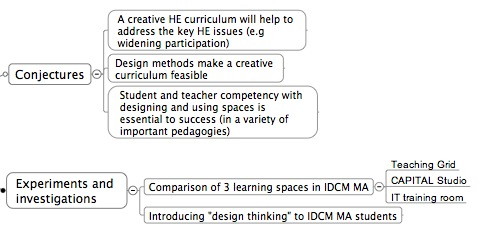
Over time the literature base will grow, but also become more focussed as the need to support very specific conjectures, experiments and investigations becomes more prominent - shifting from an "inspiration" bias towards "implementation" (to use the "design-thinking" paradigm).
Facilitating creativity in higher education: a brief account of NTFs' views, Marilyn Fryer
Published in the book Developing Creativity in Higher Education1. A report on a survey of 94 recipients of the Higher Education Academy National Teaching Fellowship (90 email questionnaires and 24 in-depth interviews)2.
The chapter begins with a survey of research into attitudes towards and perceptions of creativity amongst teachers in schools and (much less commonly) in higher education. The results of such studies seem to confirm the intuitively obvious: for example, that the valuing of creativity varied with preferred teaching styles.
The NTF survey is impressive in its sample size - Fellows from across the broad spectrum seemed to be quite keen to respond. The details of the response are equally impressive. The NTFs were asked to describe aspects of creativity. Their answers were compiled into a useful table (p.78), with "imagination" at the top (90%) and several other somewhat general notions proving to be popular, including "innovation" (76.6%) and "invention" (66.7%). However, it's interesting to see that several more tangible behaviours are rated highly, for example "seeing unusual connections" (86.7%), "combining ideas" (80%) and "generative thinking" (53.3%), suggesting a more pragmatic engagement with creative actions - indeed 92.2% of respondents believe that "creativity can be developed" p.79. Also of interest is the fact that there were no strong disciplinary biases expressed. Fryer suggests that these attitudes may be the result of the widening debate concerning creative education (p.79), with active teachers readily accepting its importance for all students.
The NTFs, however, seem less optimistic concerning the ability of HE to adopt creativity more consistently:
Most NTFs [National Teaching Fellows] are highly motivated and keen to develop students’ creativity. … Even though most of the NTFs see themselves as having more autonomy, flexibility … many struggle with challenging working conditions… responses highlight the fact that, despite some really innovative teaching, much HE provision is still geared to the previous century (in some instances, the century before that). p.82
This could be blamed upon an entrenched legacy HE culture, defining assessment goals and practices, that is biased towards bahaviours that are not creative.
Whilst 75% of the NTFs believe that the capacity to be creative enhances academic performance, few (13.5%) believe that the most academically successful students are also the most creative. p.80
Fryer concludes that "questions need to asked about the criteria for academic success." (p.87) - a significant, if not revolutionary question to pose. Assessment was especially singled-out as a blocker to a revaluation of creativity. (p.86)
________________
1 Developing Creativity in Higher Education: An Imaginative Curriculum, Norman Jackson, Martin Oliver, Malcolm Shaw and James Wisdom, Routledge 2006
2 Facilitating creativity in higher education: a brief account of National Teaching Fellows' views, Marilyn Fryer in Jackson et al 2006.
 Robert O'Toole
Robert O'Toole

 Please wait - comments are loading
Please wait - comments are loading



